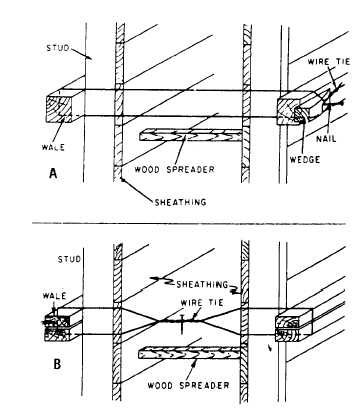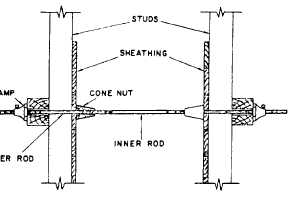Figure 7-30.-Wire ties for wall
Figure 7-31.-Snap tie.
forms.
simple wire ties, used with wood SPREADERS,
are shown in figure 7-30. The wire is passed
around the studs and wales and through small
holes bored in the sheathing. The spreader is
placed as close as possible to the studs, and the
tie is set taut by the wedge shown in the upper
view or by twisting with a small toggle, as shown
in the lower view. When the concrete reaches the
level of the spreader, the spreader is knocked out
and removed. The parts of the wire that are
inside the forms remain in the concrete; the
outside surplus is cut off after the forms are
removed.
Wire ties and wooden spreaders have been
largely replaced by various manufactured devices
that combine the functions of the tie and spreader.
Figure 7-31 shows one of these, called a SNAP
TIE. These ties are made in various sizes to fit
various wall thicknesses. The tie holders can be
removed from the tie rod. The rod goes through
small holes bored in the sheathing and also
through the wales, which are usually doubled for
that purpose. Tapping the tie holders down on
the ends of the rod brings the sheathing to bear
solidly against the spreader washers. After the
concrete has hardened, the tie holders can be
detached to strip the forms. After the forms are
stripped, a special wrench is used to break off the
outer sections of rod; they break off at the
breaking points, located about 1 in. inside the
surface of the concrete. Small surface holes
remain, which can be plugged with grout, if
necessary.
Another type of wall form tie is the TIE ROD,
as shown in figure 7-32. The rod in this type
consists of three sections: an inner section, which
is threaded on both ends, and two threaded outer
sections. The inner section, with the cones set to
the thickness of the wall, is placed between the
forms, and the outer sections are passed through
the wales and sheathing and threaded into the
cone nuts. The clamps are then threaded up on
the outer sections to bring the forms to bear
against the cone nuts. After the concrete hardens,
the clamps are loosened, and the outer sections
of rod are removed by threading them out of the
cone nuts. After the forms are stripped, the cone
nuts are removed from the concrete by threading
Figure 7-32.-Tie rod.
7-20





